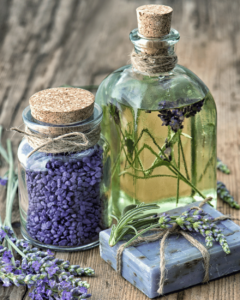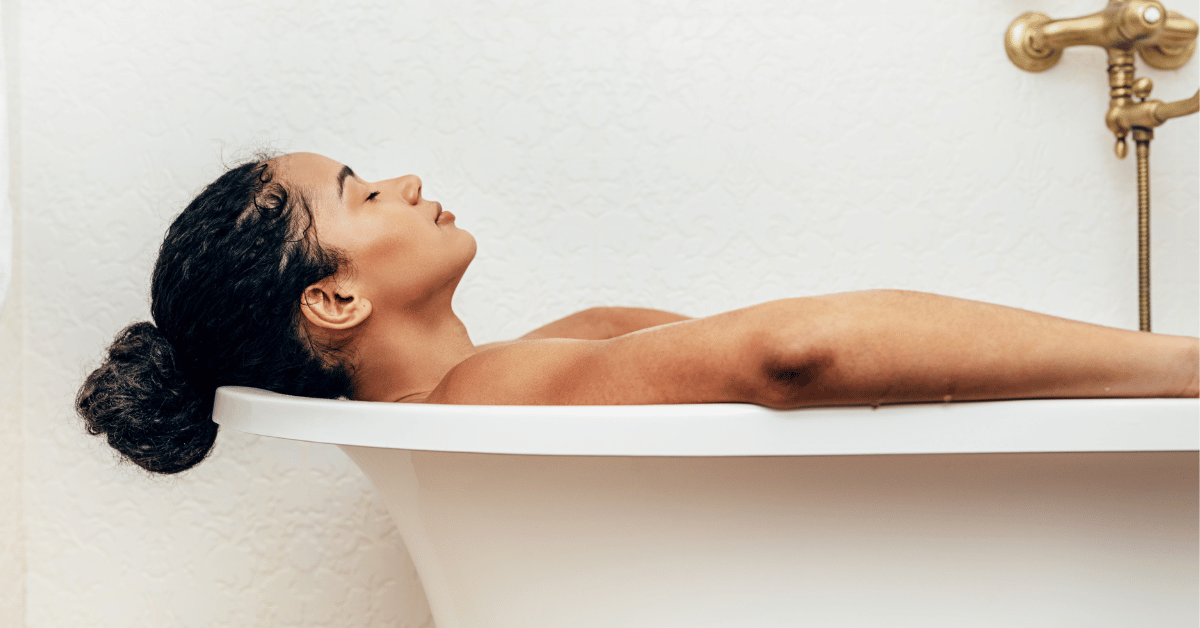The phrase “sitz bath” comes from the German word “sitzen,” which means “to sit.” A sitz bath is a therapeutic warm soak for the lower part of the body. A sitz bath can be used to alleviate the discomfort associated with hemorrhoids, and it is often used postpartum to soothe the perineum. Incorporating natural ingredients like baking soda, chamomile, witch hazel, and lavender essential oil into your sitz bath can enhance its soothing properties.
In this article, we’ll discuss the benefits of sitz baths as well as how to prepare a herbal sitz bath for hemorrhoid and perineal relief.
What Are Sitz Baths Used For?
Sitz baths can be used to gently clean and calm various ailments around the anus or perineum. They are commonly used postpartum as well as by those dealing with hemorrhoids, which are swollen veins located around the lower rectum or anus. The warm water combined with soothing ingredients makes this home remedy feel good, and it promotes healing.
For more information on hemorrhoids and how to manage them, read: What Are Hemorrhoids? Plus Tips On Prevention & Management.
Sitz Bath Ingredients & Benefits
Sitz baths can be prepared in many ways, and there really is no singular “right” way. My clinical and personal experience has allowed me to dial in on a preparation method that I find to be effective and accessible.
I use the following ingredients in my sitz baths due to their various health benefits:
pH Balancing Baking Soda
I like to include baking soda (sodium bicarbonate) in my sitz bath primarily for its pH balancing properties. As an alkaline substance, baking soda helps gently clean the area and neutralizes any acidity, which can be a source of irritation and discomfort. This balancing act helps create a more favorable environment for healing and reduces itching.
Calming Chamomile
Chamomile is well known for its calming effects (1), which make it ideal for soothing irritated skin and promoting relaxation. I simply use chamomile tea bags, something many people already have in their pantries. Nobody wants to waddle around shopping for hard to find ingredients postpartum or when dealing with hemorrhoids!
 Astringent Witch Hazel
Astringent Witch Hazel
Witch hazel is a natural astringent—it causes the contraction of skin cells and other body tissues (2)—that helps reduce swelling and pain. It is known for its healing effects on cuts, bruises, and hemorrhoids. You can use dried witch hazel bark, or a generous squirt of store bought witch hazel extract works well, too.
Soothing Lavender Essential Oil
Renowned for its gentle inflammatory support and antimicrobial properties (3), lavender can help soothe irritation and promote relaxation. A drop of quality lavender oil goes a long way.
How To Prepare An Herbal Sitz Bath
A sitz bath can be done using a small basin that sits over the toilet seat, which is great if you don’t have a bath tub or if you aren’t able or don’t want to take a full bath. A sitz bath can also be prepared in a regular bathtub. If you are preparing a sitz bath in the small basin that fits over your toilet, follow the quantities as stated. If you are going to use your tub, quadruple the amounts below to account for the increased volume you’ll need.
Ingredients
- 1 tablespoon baking soda
- 2 to 3 chamomile tea bags (or equivalent in loose leaf)
- 1 tablespoon witch hazel (or a few tablespoons of dried witch hazel bark)
- 1 drop lavender essential oil
- About 3 cups of water, or more as needed to fill your sitz bath
- A sitz bath basin or a clean bathtub*
*Note: It is important to ensure that your sitz bath or bathtub is clean to avoid infection. This is especially true if you are postpartum.
Directions
- Prepare chamomile infusion: Boil the water and pour it over the chamomile tea bags in a large bowl. If using witch hazel bark, add it to the hot water and let steep for 10 minutes to create a strong infusion. If using loose leaf tea, strain after steeping.
- Fill sitz bath or bathtub: Pour the chamomile infusion into the sitz bath or bathtub. Top it off as needed with warm (not hot) water. If you’re using your bathtub, fill it enough to cover your hips and buttocks. You could fill the tub and take a full body soak, just know that the ingredients (and their properties) will be more diluted this way. Ensure the temperature is comfortable and safe.
- Add remaining ingredients: Add a drop of lavender essential oil to the baking soda, and then dissolve the baking soda/essential oil mixture into the water. This will help the essential oil disperse into the water rather than floating on top. Mix the liquid witch hazel into the water.
- Soak for relief: Soak for 5-20 minutes.
- Gently pat area dry and apply soothing balm: Try Relieve & Restore Hem Balm.
How Often Can I Use A Sitz Bath?
Generally speaking a sitz bath can be performed as often as you’d like. Sitz baths for hemorrhoids work best as part of a larger home care plan that includes dietary adjustment, herbal care, and proper bathroom habits. If you do not notice improvement within a week or so, reach out to your medical provider.
Who Should Avoid Using A Sitz Bath?
If you have open wounds, such as a perineal tear after childbirth, you should avoid using a sitz bath until the wound has closed, unless directed otherwise by a medical professional. If your pain or itching becomes worse, contact your doctor.
If you found this article helpful, you may also enjoy: How To Safely Prepare An Epsom Salt Bath With Essential Oils, How To Use Oatmeal Baths For Soothing Itchy Skin, and Bentonite & Epsom Salt Bath For Skin Health & Detox.
Summary
A sitz bath with baking soda, chamomile, witch hazel, and lavender essential oil can offer a natural and accessible way to alleviate the symptoms of hemorrhoids or perennial discomfort after childbirth. This soothing remedy can reduce itchiness and swelling, help keep things clean, promote healing, and provide a relaxing experience to support your body’s recovery. I recommend using sitz baths as part of a larger home care plan that includes a dietary approach, an awareness of bathroom habits, and herbal remedies, like our Hem Your Rhoids™ glycerite and Relieve & Restore Hem Balm.
For more information on hemorrhoids and how to manage them, read: What Are Hemorrhoids? Plus Tips On Prevention & Management.
References:
- Srivastava, J. K., Shankar, E., & Gupta, S. (2010). Chamomile: A herbal medicine of the past with bright future. Molecular medicine reports, 3(6), 895–901. https://doi.org/10.3892/mmr.2010.377
- Oklahoma, W. S. P., PhD, DPh Bernhardt Professor, Nonprescription Products and Devices College of Pharmacy Southwestern Oklahoma State University Weatherford, Oklahoma Gabriel E. Pray, PharmD Candidate College of Pharmacy Southwestern Oklahoma State University Weatherford. (n.d.). Counseling Patients With Hemorrhoids. www.uspharmacist.com. https://www.uspharmacist.com/article/counseling-patients-with-hemorrhoids
- Kwiatkowski, P., Łopusiewicz, Ł., Kostek, M., Drozłowska, E., Pruss, A., Wojciuk, B., Sienkiewicz, M., Zielińska-Bliźniewska, H., & Dołęgowska, B. (2019). The Antibacterial Activity of Lavender Essential Oil Alone and In Combination with Octenidine Dihydrochloride against MRSA Strains. Molecules (Basel, Switzerland), 25(1), 95. https://doi.org/10.3390/molecules25010095








One Comment